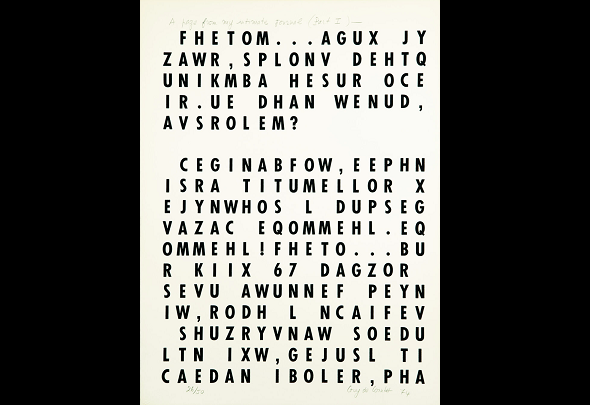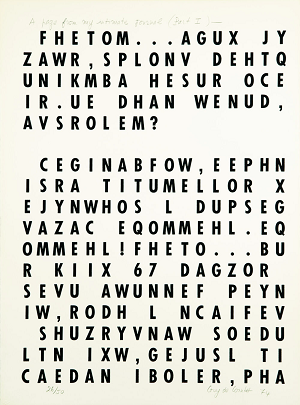Guy de Cointet’s encrypted diary excerpt
The artist Guy de Cointet has left many encrypted works. One of them – according to the title it is an excerpt from a diary – I want to go into more detail today.
I still find it amazing that French-American artist Guy de Cointet (1934-1983) is virtually unknown in the crypto scene.
Guy de Cointet
De Cointet was born in Paris and emigrated to the United States in 1966. He lived in New York and Los Angeles, where almost all his works were created. He died at the age of only 49. There is a Wikipedia entry and a website on his person.
As I reported recently, de Cointet created numerous paintings that feature encrypted text.
According to a 2021 article in the Los Angeles Times, de Cointet’s interest in cryptography developed in his youth. He always kept a low profile about his private life. He never appeared with a partner. His obvious interest in encrypted messages and his reclusive lifestyle led to speculation that he was a spy. However, there is no serious evidence of this. His early death is attributed to hepatitis C disease.
While cryptology enthusiasts have paid little attention to de Cointet, the American-by-choice has since achieved a certain reputation in the art scene – albeit mainly after his early death. The 2013 Los Angeles Times article reports on numerous museums and exhibitions that have included de Cointet’s works in their programs. The Museum of Modern Art (MOMA )in New York, arguably the most important museum of modern art anywhere, also has a number of his paintings.
A Page From My Intimate Journal (Part 1)
Already in my last article about de Cointet I reported about the following picture:
It is called “A Page From My Intimate Journal (Part 1)” and was created in 1974. The scan shown is marked “26/50” in the lower left, indicating that there are 50 copies of this work. In fact, I found several versions of it on Google Images. Some of them also have the inscription “xy/50”. But there is also one labeled “Cirrus Proof” (so probably a proof print) and one labeled “A/P”.
I could not find a “Part 2” of this work anywhere.
The cryptogram
Does the image actually show an excerpt from an “intimate diary” as the title suggests? Is the text encrypted? I don’t know. Here, first of all, is a transcription:
_FHETOM...AGUX JY
ZAWR,SPLONV_DEHTQ
UNIKMBA_HESUR_OCE
IR.UE_DHAN_WENUD,
AVSROLEM?
_CEGINABFOW,EEPHN
ISRA_TITUMELLOR_X
EJYNWHOS_L_DUPSEG
VAZAC_EQOMMEHL.EQ
OMMEHL!FHETO...BU
R_KIIX_67_DAGZOR
SEVU_AWUNNEF_PEYN
IW,RODH_L_NCAIFEV
_SHUZRYVNAW_SOEDU
LTN_IXW,GEJUSL_TI
CAEDAN_IBOLER,PHA
And here is a frequency analysis created with CrypTool 2 (of course you can also use Multi-Dec from blog reader Christian Baumann):
As blog reader Thomas Bosbach correctly noted, this looks a lot like a transposition cipher and an English plaintext. Only the T occurs unexpectedly rarely.
It can hardly be a column-wise transposition, since otherwise the blanks in the fifth line would not all be at the end.
That the text was anagrammed word by word cannot be either, since an expression like L or UE cannot be rearranged to a meaningful word.
An interesting comment came from Norbert Biermann. He sees possible allusions: “When I read DUPSEG VAZAC, for example, I can’t help but think of Alexander Dubček and Václav Havel. In the year it was written, 1974, the Prague Spring was not that long ago, so from that point of view it would fit.”
Norbert’s conclusion: “I think it’s quite possible that Cointet deliberately chose the letter frequencies this way and distributed the vowels ‘sensibly’ for the most part, but still didn’t base it on a real plaintext.”
If “A Page From My Intimate Journal (Part 1)” is decipherable, de Cointet must have used a more complex procedure than in many of his other encodings, which have long since been solved. Can a reader decode this painting anyway?
If you want to add a comment, you need to add it to the German version here.
Follow @KlausSchmeh
Further reading: Steganografische Nachricht aus dem Zweiten Weltkrieg gelöst
Linkedin: https://www.linkedin.com/groups/13501820
Facebook: https://www.facebook.com/groups/763282653806483/
[jetpack_subscription_form title=”Subscribe to Blog via






Letzte Kommentare